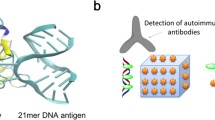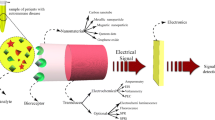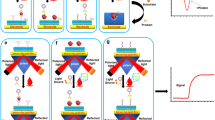Abstract
The mechanism of self-recognition of the autoantigen TROVE2, a common biomarker in autoimmune diseases, has been studied with a quartz crystal microbalance with dissipation monitoring (QCM-D) and dual polarization interferometry (DPI). The complementarity and remarkable analytical features of both techniques has allowed new insights into the onset of systemic lupus erythematosus (SLE) to be achieved at the molecular level. The in vitro study for SLE patients and healthy subjects suggests that anti-TROVE2 autoantibodies may undergo an antibody bipolar bridging. An epitope-paratope-specific binding initially occurs to activate a hidden Fc receptor in the TROVE2 tertiary structure. This bipolar mechanism may contribute to the pathogenic accumulation of anti-TROVE2 autoantibody immune complex in autoimmune disease. Furthermore, the specific calcium-dependent protein-protein bridges point out at how the TRIM21/TROVE2 association might occur, suggesting that the TROVE2 protein could stimulate the intracellular immune signaling via the TRIM21 PRY-SPRY domain. These findings may help to better understand the origins of the specificity and affinity of TROVE2 interactions, which might play a key role in the SLE pathogenesis. This manuscript gives one of the first practical applications of two novel functions (−df/dD and Δh/molec) for the analysis of the data provided by QCM-D and DPI. In addition, it is the first time that QCM-D has been used for mapping hidden Fc receptors as well as linear epitopes in a protein tertiary structure.

ᅟ





Similar content being viewed by others
References
Kakatia S, Teronpia R, Barmanb B. Frequency, pattern and determinants of flare in systemic lupus erythematosus: a study from North East India. Egypt Rheumatol. 2015;37:S55–9.
Kuhn A, Wenzel J, Weyd H. Photosensitivity, apoptosis, and cytokines in the pathogenesis of lupus erythematosus: a critical review. Clinic Rev Allerg Immunol. 2014;47:148–62.
American Lupus Foundation. 2016. http://www.lupus.org.
World Health Organization. Environmental health criteria 236. Geneva: WHO Press; 2006.
Li W, Titov AA, Morel L. An update on lupus animal models. Curr Opin Rheumatol. 2017;29:1040–8711.
Routsias JG, Tzioufas AG, Moutsopoulos HM. The clinical value of intracellular autoantigens B-cell epitopes in systemic rheumatic diseases. Clin Chim Acta. 2004;340:1–25.
Franceschini F, Cavazzana I. Anti-Ro/SSA and La/SSB antibodies. Autoimmunity. 2005;38:55–63.
Kelekar A, Saitta MR, Keene JD. Molecular composition of Ro small ribonucleoprotein complexes in human cells. Intracellular localization of the 60- and 52-kD proteins. J Clin Ivest. 1994;93:1637–44.
Slobbe RL, Pluk W, van Venrooij WJ, Prujin GJM. Ro ribonucleoprotein assembly in vitro: identification of RNA-protein and protein-protein interactions. J Mol Biol. 1992;2:361–6.
Chen X, Taylor DW, Fowler CC, Galan JE, Wang HW, Wolin SL. An RNA degradation machine sculpted by Ro autoantigen and noncoding RNA. Cell. 2013;153:166–77.
Stein AJ, Fuchs G, Fu C, Wolin SL, Reinisch KM. Structural insights into RNA quality control: the Ro autoantigen binds misfolded RNAs via its central cavity. Cell. 2005;121:529–39.
Reed JH, Gordon TP. Autoimmunity: Ro60-associated RNA takes its toll on disease pathogenesis. Nat Rev Rheumatol. 2016;12:136–8.
Sim S, Weinberg DE, Fuchs G, Choi K, Chung J, Wolin SL. The subcellular distribution of an RNA quality control protein, the Ro autoantigen, is regulated by noncoding Y RNA binding. Mol Biol Cell. 2009;20:1555–64.
Reed JH, Jackson MW, Gordon TP. A B cell apotope of Ro 60 in systemic lupus erythematosus. Arthritis Rheum. 2008;58:1125–9.
Wolin SL, Reinisch KM. The Ro 60 kDa autoantigen comes into focus: interpreting epitope mapping experiments on the basis of structure. Autoimmun Rev. 2006;5:367–72.
Routsias JG, Tzioufas AG. B-cell epitopes of the intracellular autoantigens Ro/SSA and La/SSB: tools to study the regulation of the autoimmune response. J Autoimmun. 2010;35:256–64.
Whittaker CA, Hynes RO. Distribution and evolution of von Willebrand/integrin a domains: widely dispersed domains with roles in cell adhesion and elsewere. Mol Bio Cell. 2002;13:3369–87.
Lacy DB, Wigelsworth DJ, Scobie HM, Young JA, Collier RJ. Crystal structure of the von Willebrand factor a domain of human capillary morphogenesis protein 2: an anthrax toxin receptor. Proc Natl Acad Sci U S A. 2004;101:6367–72.
O’Brien CA, Wolin SL. A possible role for the 60-kD Ro autoantigen in a discard pathway for defective 5S rRNA precursors. Genes Dev. 1994;8:2891–903.
Chen X, Wolin SL. The Ro 60 autoantigen : insights into cellular function and role in autoimmunity. J Mol Med (Berl). 2004;82:232–9.
Escorihuela J, González-Martínez MA, López-Paz JL, Puchades R, Maquieira A, Gimenez-Romero D. Dual-polarization interferometry: a novel technique to light up the nanomolecular world. Chem Rev. 2014;115:265–94.
do Nascimento NM, Juste-Dolz A, Bueno PR, Monzó I, Tejero R, Lopez-Paz JL, et al. Mapping molecular binding by means of conformational dynamics measurements. RSC Adv. 2018;8:867–76.
do Nascimento NM, Juste-Dolz A, Grau-García E, Román-Ivorra J, Puchades R, Maquieira A, et al. Label-free piezoelectric biosensor for prognosis and diagnosis of systemic lupus erythematosus. Biosens. Bioelectron. 2016;90:166–73.
Seo MH, Park J, Kim E, Hohng S, Kim HS. Protein conformational dynamics dictate the binding affinity for a ligand. Nat Commun. 2014;5:3724.
Lakshmanan RS, Efremov V, O’Donnell JS, Killard AJ. Measurement of the viscoelastic properties of blood plasma clot formation in response to tissue factor concentration-dependent activation. Anal Bioanal Chem. 2016;408:6581–8.
Fakhrullin RF, Vinter VG, Zamaleeva AI, Matveeva MV, Kourbanov RA, Temesgen BK, et al. Quartz crystal microbalance immunosensor for the detection of antibodies to double-stranded DNA. Anal Bioanl Chem. 2007;388:367–75.
Shen F, Rojas OJ, Genzer J, Gurgel PV, Carbonell RG. Affinity interactions of human immunoglobulin G with short peptides: role of ligand spacer on binding, kinetics, and mass transfer. Anal Bioanl Chem. 2015;408:1829–41.
Fogarty AC, Laage D. Water dynamics in protein hydration shells: the molecular origins of the dynamical perturbation. J Phys Chem B. 2014;118:7715–29.
Born B, Kim SJ, Ebbinghaus S, Gruebelebc M, Havenith M. The terahertz dance of water with the proteins: the effect of protein flexibility on the dynamical hydration shell of ubiquitin. Faraday Discuss. 2009;141:161–73.
Yoshimi R, Ueda A, Ozato K, Ishigatsubo Y. Clinical and pathological roles of Ro/SSA autoantibody system. Clin Dev Immunol. 2012;2012:606195.
Boire G, Gendron M, Monast N, Bastin B, Ménard HA. Purification of antigenically intact Ro ribonucleoproteins; biochemical and immunological evidence that the 52-kD protein is not a Ro protein. Clin Exp Immunol. 1995;100:489–98.
Gazzaruso C, Montecucco CM, Geroldi D, Garzaniti A, Finardi G. Severe hypercalcemia and systemic lupus erythematosus. Joint Bone Spine. 2000;67:485–8.
Hassan AB, Lundberg IE, Isenberg D, Wahren-Herlenius M. Serial analysis of Ro/SSA and La/SSB antibody levels and correlation with clinical disease activity in patients with systemic lupus erythematosus. Scand J Rheumatol. 2002;31:133–9.
Huang RY, Chen G. Higher order structure characterization of protein therapeutics by hydrogen/deuterium exchange mass spectrometry. Anal Bioanal Chem. 2014;406:6541–58.
Yu F, Roy S, Arevalo E, Schaeck J, Wang J, Holte K, et al. Characterization of heparin-protein interaction by saturation transfer difference (STD) NMR. Anal Bioanal Chem. 2014;406:3079–89.
Rizzuto R, Pozzan T. Microdomains of intracellular Ca2+: molecular determinants and functional consequences. Physiol Rev. 2006;86:369–408.
Gaipl US, Kuhn A, Sheriff A, Munoz LE, Franz S, Voll RE, et al. Clearance of apoptotic cells in human SLE. Curr Dir Autoimmun. 2006;9:173–87.
Falati S, Edmead CE, Poole AW. Glycoprotein Ib-V-IX, a receptor for Von Willebrand factor, couples physically and functionally to the Fc receptor gamma-chain, Fyn, and Lyn to activate human platelets. Blood. 1999;94:1648–56.
Muñoz LE, Lauber K, Schiller M, Manfredi AA, Herrmann M. The role of defective clearance of apoptotic cells in systemic autoimmunity. Nat Rev Rheumatol. 2010;6:280–9.
Acknowledgements
We would like to thank Sylvia Daunert for her invaluable help with the discussion of the paper.
Funding
Furthermore, we acknowledge financial support from the Generalitat Valenciana (GVA-PROMETEOII/2014/040) as well as the Spanish Ministry of Economy and Competitiveness and the European Regional Development Fund under award numbers CTQ2013-45875-R and CTQ2013-42914-R.
Author information
Authors and Affiliations
Corresponding authors
Ethics declarations
Competing interests
The authors declare that they have no conflict of interest.
Additional information
Published in the topical collection Young Investigators in (Bio-)Analytical Chemistry with guest editors Erin Baker, Kerstin Leopold, Francesco Ricci, and Wei Wang.
Electronic supplementary material
ESM 1
(PDF 0.98 MB)
Rights and permissions
About this article
Cite this article
Juste-Dolz, A., do Nascimento, N.M., Monzó, I. et al. New structural insights into the role of TROVE2 complexes in the on-set and pathogenesis of systemic lupus erythematosus determined by a combination of QCM-D and DPI. Anal Bioanal Chem 411, 4709–4720 (2019). https://doi.org/10.1007/s00216-018-1407-x
Received:
Revised:
Accepted:
Published:
Issue Date:
DOI: https://doi.org/10.1007/s00216-018-1407-x




